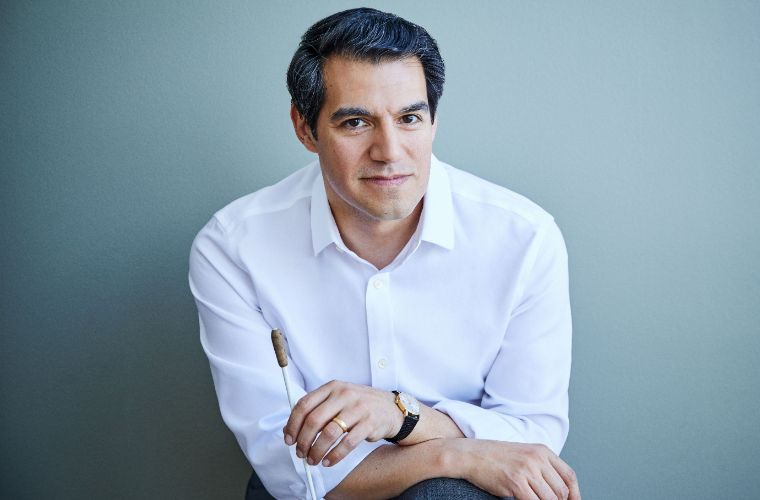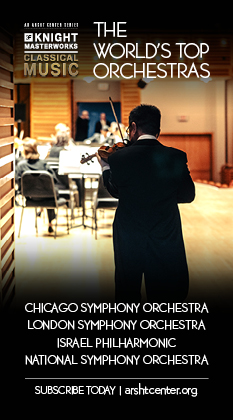Harth-Bedoya leads New World in high-stepping Latin & American program
West Side Story has proven to be Leonard Bernstein’s most enduring score. The modern adaptation of Romeo and Juliet signaled a new level of sophistication for the Broadway musical. In the early 1960’s, orchestrators Irwin Kostal and Sid Ramin (working under Bernstein’s supervision) adapted excerpts from the score into a suite of “Symphonic Dances.” That opus gave the music additional visibility as a concert work.
At the New World Symphony’s concert on Saturday night at the Arsht Center, Miguel Harth-Bedoya led a pitch-perfect account of that potpourri, concluding an evening devoted mostly to jazz- and Latin-influenced creations.
Bedoya captured both the vitality and lyricism of Bernstein’s voice without resorting to overdrive, The “Mambo” sizzled, and the “Cha-Cha” was light on its feet. Lush strings summoned the hope and pathos of “Somewhere.” The strands of the “Cool Fugue” were cleanly delineated and the percussion section got a real workout in the unhinged violence of the “Rumble.”
With stellar solo contributions by first-chair string players, solo horn and trumpet, the entire ensemble played in peak form. Harth-Bedoya’s idiomatic affinity for Bernstein’s distinctive melding of dissonance and melodic inspiration took the full measure of the score.
Combining jazz and classical elements in an orchestral work is a tricky balancing act. Bernstein and Gershwin were masters of it. Jazz pianist-composer Billy Childs appears to be another artist who manages this fusion effectively.
Childs’ Diaspora – Concerto for Saxophone and Orchestra (co-commissioned by the New World Symphony) featured the brilliant saxophonist Steven Banks as soloist. Inspired by poems of Nayyirah Waheed, Claude McKay and Maya Angelou, the 20-minute composition traces the arc of the African-American experience from the horrors of slavery to hope for a brighter day.
From a lilting opening theme to an astringent trumpet, percussive blasts and bluesy riffs, culminating in an uplifting melody, Child’s score is both virtuosic and deeply expressive. Unlike many pop-classical compendiums where the orchestra seems merely pasted on, Child’s orchestral writing is varied and masterfully conceived. Cast in one continuous arc with three sections, the concerto is both a virtuosic showpiece for the soloist and a rollercoaster of emotions.
Alternating between soprano and baritone sax, Banks articulated rapid-fire figures with dazzling speed and urgency. A lengthy cadenza exploits the outer reaches of the instrument’s range. Banks’ aplomb in both the challenging pyrotechnics and somber proclamations was consistently impressive.
Harth-Bedoya was fully attuned to the work’s dark and light outbursts, leading a precise and secure performance. Childs’ work is a winner; loud shouts and a standing ovation greeted Banks and Harth-Bedoya following the performance.
Conducting fellow Molly Turner took the podium for Jimmy López-Bellido’s Fiesta – Four Dances for Orchestra. Mixing electronic techno-pop with extended European academic compositional techniques, Bellido’s appealing concoction could be a pops-concert staple for the 21st century. Fierce Latin dance rhythms circulate through the 11-minute vignette. The score calls for an ensemble’s dexterity and tight cohesion and the New World fellows were fully up to the task. Turner conducted with snap and rhythmic exactitude.
The concert’s outlier was Samuel Barber’s Symphony No. 1, the program’s opener. This score was written during Barber’s Italian sojourn in the mid 1930’s and became the first American work played by the Vienna Philharmonic (at the 1937 Salzburg Festival under Artur Rodzinski). All the hallmarks of Barber’s compositional voice are present in this early work. The big dramatic flourishes, soulful oboe melodies and orchestral grandeur are tightly wound in this compact, 20-minute opus.
Harth-Bedoya melded the symphony’s contrasting episodes into a taut symphonic drama. The big, surging opening motif elicited passion and the deep sonority of the violas sustained the secondary subject. The fugal section was assayed with exceptional clarity, and individual voices fully transparent. One hopes this gifted Peruvian-born conductor will return to lead more of the repertoire of the significant American symphonists of the 1930’s and 40’s in future seasons.
Michael Linville conducts the New World Symphony percussion fellows in John Cage’s First Construction on Metal, Allison Loggins-Hull’s Hammers, Gabriela Ortiz’s Liquid Borders and György Ligeti’s With Pipes, Drums, Fiddles featuring soprano Katalin Károlyi 7:30 p.m. October 27 at the New World Center in Miami Beach. nws.edu
Posted in Performances
Leave a Comment
Sun Oct 22, 2023
at 1:51 pm
No Comments




